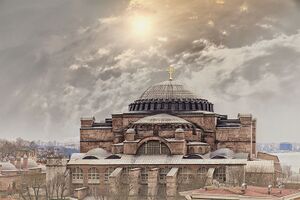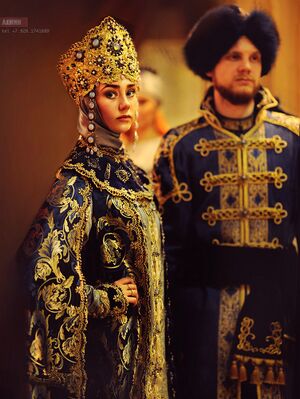Thraysia
This article is incomplete because it is pending further input from participants, or it is a work-in-progress by one author. Please comment on this article's talk page to share your input, comments and questions. Note: To contribute to this article, you may need to seek help from the author(s) of this page. |
Thraysian Empire Βασιλεία Ῥωμαίων | |
|---|---|
| Motto: "May the Lord guide us" | |
| Anthem: Απολυτίκιο του Τιμίου Σταυρού_(Thraysia) | |
| Capital and largest city | Konstantinopolis |
| Official languages | Koine Hellenic |
| Ethnic groups |
|
| Religion | Eastern Orthodox |
| Demonym(s) | Thraysian |
| Government | Absolute Monarchy |
• Emperor | Alexios VIII Gregoras |
• Heir | Alexios VIV Gregoras |
| Legislature | Imperial Council |
| Establishment | |
| Population | |
• 2019 estimate | 94,593,874 |
| GDP (nominal) | 2018 estimate |
• Total | $1,774,202,700,744 |
• Per capita | $18,756 |
| Currency | Bezant (☧) (BZT) |
| Time zone | Thraysian Imperial Time |
| Date format | mm-dd-yyyy |
| Driving side | left |
| Calling code | +32 |
Thraysia, officially the Thraysian Empire, is a sovereign country located in the far east of Belisaria, sharing borders with Vardana and Uluujol. It has coasts among the Periclean and Ozeros Seas. With over 94 million subjects, it is one of the more populated nations in the world.
Thraysia is a semi-federal absolute monarchy. The current Emperor is Alexios VIII, who has reigned since 2001. The Emperor remains the primary figure in politics and is the final authority in all political decisions. In theory, the Emperor is acclaimed to have absolute power, claiming titles such as "sole ruler of the world" and "peer of the apostles." In practice, the Thraysian Charter of Liberties, the concept of "antiemperors," and semi-federal autonomy provide protections against tyranny.
The heartland of the Thraysian Empire traces its roots to Hellenic settlements among its coasts, its indigenous peoples, and not!Macedonian invaders. Some of the region was unified under the ancient Empire until its collapse and fall to Latin rule. The Thraysian Empire officially formed as a client King organized a large-scale rebellion among its eastern provinces. It grew into an Empire that would become one of the most powerful economic, cultural, and military force in southeastern Belisaria. Later, it would be challenged by the rise of the Holy Audonian Empire and the Latin Empire. Barbarian invaders and Caliphate invasions would result in its reduction of size. Eventually, it fell to the Tuluran Caliphate in the late 15th century.
The Thraysian Empire revived during the reconquest era in the 18th century. As it seemed to have fallen somewhat behind its western neighbors, Stephanos I (1751-1784) began enacting reforms to forcibly westernize Thraysia in hopes of its modernization. It replaced many of its social and political systems dating to the Middle Ages with ones that were based on western models and Arthuristan Illumination. Westernization efforts applied much more to the upper class than the commoners. As the wealth gap increased under the "pseudo-industrialization" era and caused social unrest, a violent uprising overthrew the Thraysian government with a new one that began the "nationalist revolution." A cultural renaissance flourished and revived aspects of medieval Thraysian culture while forming an "anti-western" identity.
The modern day Empire is a developed market economy, though it remains somewhat behind the most developed nations of Belisaria. Its economy is driven by industries such as manufacturing, textiles, and mining of gold and other natural resources in its plentiful deposits down south.
Thraysia is known for being a fervently religious and extremely conservative society, fueled by a long-lived nostalgia for the medieval Thraysian Empire and its success. Its religious life is characterized by the Eastern Orthodox Church, which plays a large influence in politics. Culturally, the Empire is multi-ethnic, with separatist sentiments among its not!Slavic and not!Armenian peoples.
History
Geography
Politics
Economy
Demographics
Religion
The Thraysian Empire is characterized by Eastern Christianity, taking a much more mystical approach to theology than their western Fabrian counterparts. Initially one church, theological differences and political factors separated the east and west. Eastern Christianity has a pervasive influence on every aspect of Thraysian life. Church and state are intertwined, legitimizing Imperial rule and influencing Imperial authority and laws to be in line with Orthodox principles. It also provides a cultural identity to Thraysians. Beyond ethnicity and association with the Empire, Thraysians are Orthodox or "right-thinking." Relative to other nationalities, Thraysians are extremely religious with the Church playing a large role in their lives.
Thraysia is home to the Ecumenical Patriarch in Konstantinopolis, the Ecumenical Patriarch of whom is first among equals in the entire Orthodox Church.
Romaikos's religion is a continuous inspiration to its culture, especially in arts and architecture. The Empire has continuously constructed large cathedrals for centuries. Among the most famous and oldest ones is Hagia Vasiliki. Built in 518 AD, Hagia Vasiliki is often associated as the symbol of Konstantinopolis.
Historically, the ancient Thraysian Kingdom followed a form of Hellenic Paganism that blended in with the traditional myths of indigenous Chersonians. Judaism had a prescence among the southern areas of Chersonia. Upon its arrival, Christianity was quick to spread in Chersonia. The peninsula would become one of the world's first centers of Christianity. Eventually, the Latin Empire would convert to Christianity. Chersonia was home to many Church fathers and had greatly contributed to the development of eastern Christianity. Orthodox Christianity was continually supported by imperial authority in the independent Thraysian Empire. However, heretic Emperors and Patriarchs occasionally arose. The loss of Thraysian territory to the caliphates promoted the spread of Iconoclasm and several Christian heresies until the reign of Empress Dominica. During the Reconquest Era in the 17th to 18th centuries, extensive efforts were made to re-Christianize the Thraysians after Caliphate rule. Religious minorities were required to convert or face expulsion. Under the reign of Empress Placidina, the Orthodox Inquisition was initiated to identify heretics among religious minorities that were forcibly converted, primarily Jews and Azdarins.
There has been a mild increase in irreligion during recent years, though irreligious people are not extremely outspoken of their beliefs due to social pressure.
Culture
Culture
Architecture
Art
Thraysian art is extremely conservative and sometimes critiqued as stagnant. Despite being in an age of technology, classical art styles continue to remain commonplace in the Empire and co-exist with digital art and photography. Thraysia is well known for its mosaics, though frescos and paintings are used more frequently in smaller artworks. Much of its classical art styles relate with religious expression. Their styles reflect images representing the divine, absolute, and imaginative, rather than realistic depictions. As such, they tend to be abstract and two-dimensional. A golden background, a common depiction of heaven in Thraysian Christianity, is frequently in both religious and secular art. Brilliant and vibrant color palettes are used over realistic expression. Bright stones, gold, and precious metals can be found in larger artworks.
The most common type of art in Thraysia is Iconography. Icons are held by Thraysian Orthodox Christians as sacred and having existed since the beginning of Christianity. They are considered to be windows into Heaven. It is quite rare to come across a Thraysian household without a corner of Icons.
Fashion
Thraysians are well known for their exotic clothing that greatly differs from modern Belisarian attire. Upper class Thraysians and Imperial elites are known for their detailed and sophisticated dress. The men wear robes and dalmatica while women wear stola and long dresses. They are made of rich silks, jewels, and sometimes gold. Ornate patterns and designs cover their garments. The most expensive of dresses are worn by the Emperor and the highest-ranking Imperial officials. Of the upper class, men and women alike wear an extensive amount of jewelry.
Thraysian commoners wear much simpler clothing. Men's commoner clothing typically consists of foustanella skirts or tunics. In warmer times and climates, men sometimes wear baggy trousers known as vraka along with shirts known as poukamiso. Women's dresses include a poukamiso, sleeveless vest, apron, sash, and sometimes a scarf in colder climates. Jewelry is rare common among commoners.
Western clothing has occasionally sprung up as temporary trends in some cities, though they are typically regarded as "barbarian attire" by more conservative Thraysians.
Music
Cuisine
The Cuisine of Thraysia often varies by region. Contemporary Macedonian cuisine makes wide use of vegetables, grains, olive oil, fish, wine, meat, and olives. Other common ingredients include pasta, cheese, lemon juice, herbs, bread, and yogurt. Wheat and barley are the most common graints. Dessert ingredients mostly include fruits and occasionally pastries. Some influence comes from neighboring countries such as Tyrenes and Shastara.
Southern Thraysian cuisine carries a more Scipian and oriental flavor than contemporary cuisine in the western provinces. A larger use of spices, curry, stews are found in such cuisine. Southern Thraysia is also famous for its variety of mezes, kebabs, and dough-based desserts such as balklava, sobiyet, kunefe, and kayadif.
Sports
The National Sport of the Thraysian Empire is football. The Empire champions its football team as among one of the best in the world. It is commonly watched by almost all subjects of the Empire. One may frequently find young Thraysian playing football in parks and in streets.
Other popular sports in Thraysia include golf, rugby, shooting, and running.
[[Category:Countries]




